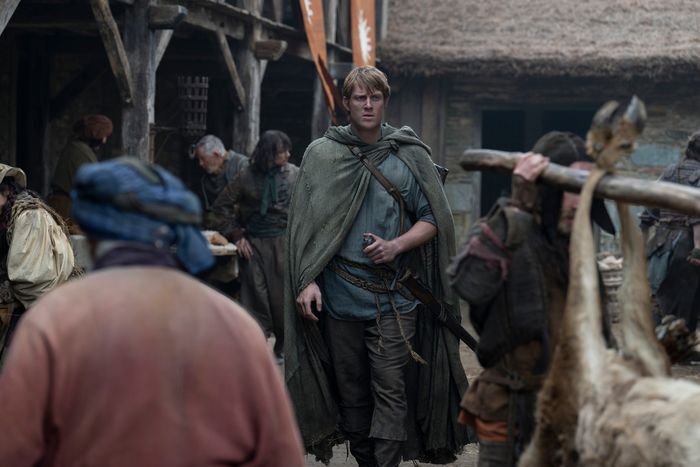
Prophecy schmophecy. Daemon’s big moment in House of the Dragon’s second-season finale was an equally big one for the series as a whole. His experience of the “Song of Ice and Fire” prophecy, meant to be the culmination of his extended getaway in Harrenhal, seemingly reconfigures his entire psychology in service to Rhaenyra, thus removing major conflict between two main characters. For viewers, the vision is communicated as a ham-fisted bit of brand management: We see images from Game of Thrones, complete with flashes of the Night King and a lingering Daenerys shot, that ultimately ties House of the Dragon together with its predecessor in a more overt way than ever before. I think this is supposed to be one of the season’s biggest payoffs, but oh, the groan I made when the vision played on my screen. Not this nonsense again. If more of this is what we’re going to get from the rest of HBO’s planned Game of Thrones spinoffs, the next in line of which will be A Knight of the Seven Kingdoms, this franchise is going to be as much fun as a sack of potatoes.
This insistence on explicitly tying a spinoff back to its main work pushes Game of Thrones into tricky Star Wars territory. The latter has become a franchise so hobbled by its cowardly inability to commit to anything other than its original characters (especially the Skywalkers) and ideas (good versus evil) that it’s basically become stuck inside itself. You can’t just tell a good story; you always need to sprinkle a Luke here, a Yoda there, which means very few characters get to live their own tales on their own terms. It’s sad. It’s boring! Still, it’s not hard to see where that insistence comes from. Base fandom is a limiting but nevertheless impactful force, and the strategy of playing to the base generally fits well with conservative corporate incentives: Game of Thrones was a hit, therefore to make the spinoff a hit, there must be Game of Thrones, be it a reused prophesy or a reused opening theme song. But drawing from the same well over and over again eventually yields diminishing returns, and if a franchise can’t grow into being about anything other than itself, then it’s never truly building a future.
One hopes that this franchise conservatism is limited to just House of the Dragon. This is the first spinoff out of the gate, after all, and I can understand thinking of it like a bridge to a future generation of shows. But this should mean A Knight of the Seven Kingdoms, which adapts a series of George R.R. Martin’s novellas collectively known as The Tales of Dunk & Egg, gets to steer as far away from the shadow of Game of Thrones as it can and fully lean into its own identity.
The framework for such autonomy is baked into the source material, which takes place after the events of House of the Dragon and before Game of Thrones: These novellas are largely self-contained adventures featuring Ser Duncan the Tall, a Westerosi hedge knight (think a rōnin or a gig-economy knight), and his squire, “Egg,” who happens to be a royal prince in disguise. Sure, Egg is actually King Aegon Targaryen the Fifth, which means there’s always the possibility he might talk about that one time his great-grand-something went to war with her half-brothers because her best friend misinterpreted her king-husband’s last words. Which would be perfectly fine as long as it’s in the form of flavor chitchat between the two main characters while they’re hanging out on the Kingsroad eating kidney pies or whatever. Egg’s family history, and the fate of his lineage, is an important aspect of his character, but it shouldn’t necessarily be what the show is about. Again, the source material already provides the spinoff with fresh purpose: These stories are fundamentally explorations of what knighthood means as a philosophy and an institution in the moral morass that is Westeros. A Knight of the Seven Kingdoms should specifically be about that; but if Egg winds up being a big Prophecy Guy too, then, well, the franchise is screwed.
Committing to A Knight of the Seven Kingdoms as a self-contained narrative about two traveling adventurers would allow the franchise to play in fresher lanes. In particular, it gets us away from the “I want to rule the kingdom” stuff and the “We’ve got to save the world” stuff — big aspects of Game of Thrones that are now repeated in House of the Dragon — and down to the earthier textures of Westeros. Ironically, it is the Star Wars franchise that gives us the best possible model for what A Knight of the Seven Kingdoms can be. I am, of course, talking about Andor, the Tony Gilroy–led Rogue One prequel that took what little narrative space it was given between major texts and found a whole new universe to build. Andor’s grand pleasures were rooted in two things. First, it dove headfirst into exploring hefty themes around ordinary people rebelling against fascism, an idea that was always kinda present in Star Wars but never given its due onscreen until Rogue One. Second, Andor’s ground-level perspective allowed for a more tangible experience of its fictional worlds. Coruscant had dense housing, and the windows of its residential units tended to be grimy. The people of Ferrix had their own rituals stemming from their own unique histories. To sneak into a city, you had to park your ship in one place and literally take a bus.
This sense of pace and texture wouldn’t be entirely new to Game of Thrones. The original show’s earlier seasons really made you feel the scale of the world, such that pairs of characters could take entire episodes (or seasons!) getting from one place to another. This quality largely dissipated as the storytelling accelerated the pace of action in the final seasons, and the show suffered for it, because it was in these extended stretches that you got to spend time with these characters as they got to just be who they are and progressively evolve in relation to each other and the world around them. Brienne and Jaime wouldn’t be as interesting a duo if we didn’t have to follow them as they trudged through Westeros. Same goes with Arya and the Hound, Tyrion and Jorah, and so on.
This quality is not completely missing from House of the Dragon. The second season had large chunks dedicated to Ulf, Alyn, and the other smallfolk who would become dragonriders, even if they weren’t developed well. This is also part of why I ended up liking the shockingly extensive stretch of Tyland Lannister in the finale, “The Queen Who Ever Was” — he’s just a dude trying to do his job and gets pounded in the mud for his troubles. That’s fun! It’s also why I enjoyed the oddball pairing of Criston Cole and Gwayne Hightower, who remains criminally underused. Cole might’ve started out the season as a supreme edgelord, but by the end, he seems to be transitioning into a vessel for ground-level war weariness. The Targaryens are up in the skies burning the crap out of one another, but Criston and Gwayne are now just two sad dudes trying to do their jobs and avoid the fate of barbecue. That’s relatable and tragique! Much more so than a royal conflict whose stakes are driven by events far out into the future that we viewers already know the ending to.
Andor might’ve turned out to be a wild outlier for Star Wars, but, boy, what a vision of the future it presented for the franchise. A Knight of the Seven Kingdoms is in a position to do the very same thing. Let’s spend more time in the dirt of Westeros. What do smallfolk apartments in the Vale look like? How does a tavern in the Riverlands make money? What does it mean to be a valorous knight in Westeros, a land filled with human darkness? These are new and interesting questions worth exploring, and if the Game of Thrones franchise is to have any real future, A Knight of the Seven Kingdoms would lean into them.


